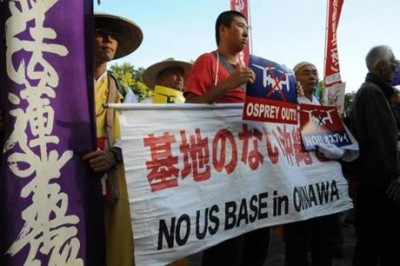Japan Resumes Construction on New US Base in Okinawa Despite Local Opposition
The majority of the people living in Okinawa oppose the project

All Global Research articles can be read in 51 languages by activating the Translate Website button below the author’s name (only available in desktop version).
To receive Global Research’s Daily Newsletter (selected articles), click here.
Click the share button above to email/forward this article to your friends and colleagues. Follow us on Instagram and Twitter and subscribe to our Telegram Channel. Feel free to repost and share widely Global Research articles.
New Year Donation Drive: Global Research Is Committed to the “Unspoken Truth”
***
Japan has resumed construction work on a landfill for the relocation of a US military base in Okinawa despite strong opposition from the island’s governor and residents.
Japan’s central government overrode Okinawa Governor Denny Tamaki’s objections to resume the landfill work, a move Japanese media has described as “unprecedented.” Tamaki said the central government’s actions were “extremely regrettable.”
The landfill construction is part of a project to relocate US Marine Corps Air Station Futenma from Ginowan, Okinawa, to Henoko, a coastal area on the east side of the island. In a 2019 referendum, 72% of Okinawan voters opposed the construction of the landfill, and a poll in 2022 found that 68% of Okinawans feel their opinions on US bases in their prefecture are being ignored.
While Okinawa only accounts for 0.6% of Japan’s territory, the prefecture hosts 70.6% of all US military bases in Japan. In total, 31 US military facilities are in Okinawa.

Map showing US bases in Okinawa (Source: Okinawa Prefectural Government)
According to Japanese officials, the landfill and work to reinforce soft ground in Henoko will take over nine years. Another three years will be needed to complete the transfer of the US military base, putting the date of the completed project in the mid-2030s.
There is a strong anti-base movement in Okinawa, but their concerns are being ignored as the US is building its military presence in the region to prepare for a future war with China. The US views Okinawa as key to the strategy and plans to deploy new units of anti-ship missile-armed Marines to the island by 2025.
The opposition to the US bases in Okinawa is due to environmental damage, the conduct of US troops on the island, and the dark history of World War II. According to a monument at the Okinawa Prefectural Peace Memorial Museum, 149,584 civilians were killed during the Battle of Okinawa between US and Japanese Imperial forces in 1945.
The US ended its formal occupation of Okinawa in 1972 and handed it back to Japan, but the population has continued to oppose the US military presence. Okinawa was previously part of the independent Ryukyu Kingdom but was annexed by Imperial Japan in 1879.
*
Note to readers: Please click the share button above. Follow us on Instagram and Twitter and subscribe to our Telegram Channel. Feel free to repost and share widely Global Research articles.
Dave DeCamp is the news editor of Antiwar.com, follow him on Twitter @decampdave.

